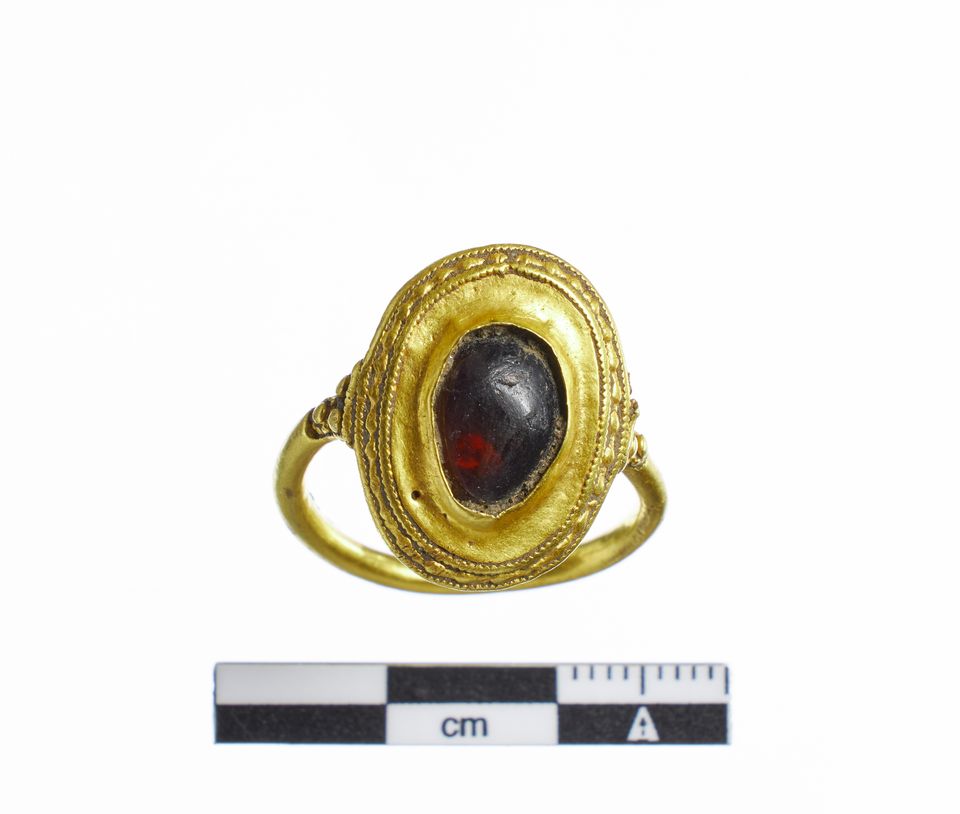Nádherný prsten. 
Detectorist finds exceptional gold ring from the 5th century, refers to a previously unknown principality
Categories: Nálezy nejenom s detektorem ve Skandinávii
With the help of metal detectors, a very rare, 1,500-year-old Merovingian gold ring made of 20-carat gold was discovered in Emmerlev, Jutland. It's a reference to Germanic mythology and the excellence of Frankish craftsmanship. The ring suggests a connection to a hitherto unknown princely family in south-western Jutland.
When thirty-nine-year-old Lars Nielsen discovered a large gold ring with a red semi-precious stone, he realised he had made the find of a lifetime. "I was so excited and amazed that I could hardly say anything, and that doesn't usually describe me. But without a doubt, this is my best find yet. I am very proud and honoured to be able to contribute a piece of our shared history both locally and nationally," described the happy finder.
The ring is set with a red semi-precious stone, featuring gold spirals (horns?) on the underside and granulated trident decoration on the transition between the ring and the stone's setting. For the Germanic peoples, the almandine garnet was a symbol of power. The spirals and beadwork are characteristic of the highest quality of Frankish manufacture. Jewellery and rings of this type were worn exclusively by the elite of the Merovingian dynasty.
"The gold ring not only reveals a possible new princely family in Emmerlev, but also links the area to one of the greatest European power centres of the Iron Age. The ring is probably female and may have belonged to the prince's daughter, who was married to a prince in Emmerlev. Gold was usually reserved for diplomatic gifts," said Kirstine Pommergaard, curator at the National Museum of Denmark.
The ring dates from the 5th-6th century. It was found just 10 kilometres from the site of the unique gold horns from the 4th century. Two kilometres from the Trælbanken ring mound from the first century, which may still have been in use at the time of the gold ring: "The considerable number of large finds in the vicinity paints a picture of a power elite that ruled the area for perhaps hundreds of years," believes Anders Hartvig of Museum Sønderjylland.
The archaeologists do not believe that the ring was simply lost, for example, during a trading trip. However, other objects have been found in the same area - most notably two gold and seven silver coins or Frisian turned pottery, which confirm contact with the Merovingian area, probably through allies in Friesland. Moreover, the ring is set with a red semi-precious stone, a well-known symbol of power among the Norsemen, whereas the gold rings of the elite Merovei were usually set with coins or a seal-ring style plaque. All indications are that the ring was intended to serve as a symbol of power in the Nordic lands.
In total, nearly a thousand ancient and medieval artefacts have been found at Emmerlev (gold and silver trade coins, textiles, ceramics), proving that there was a busy international trade here for centuries. The Ribe trading post was just 50 km north of Emmerlev, an important stop on the lucrative Wadden Sea trade network.
According to Lars Nielsen, it is the local Danish history that is the most interesting aspect of the discovery of the ring, a replica of which he had made and gave to his wife as a Christmas present. "Hopefully it will be inherited by a family who in the future will be able to identify where it was found and submit a letter to the National Museum describing the ring's special history and significance. So this way it will stay in our family," the finder concluded.
Roman Nemec
Sources: natmus.dk, thehistoryblog.com, via.ritzau.dk







The article is included in categories:




